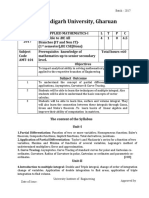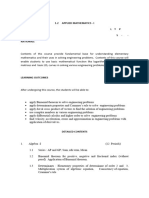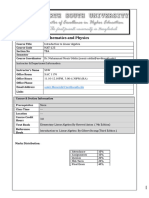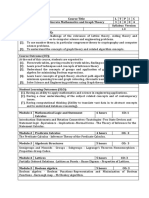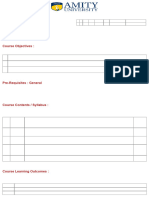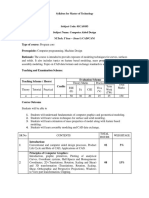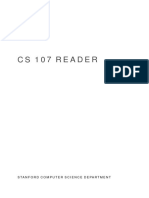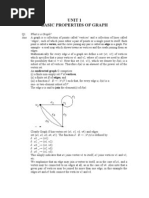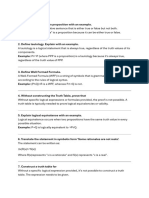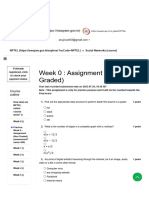CS309 Graph Theory and Combinatorics
Uploaded by
RAJAT DIXITCS309 Graph Theory and Combinatorics
Uploaded by
RAJAT DIXITCourse L-T-P Year of
Course Name
code Credits Introduction
CS309 GRAPH THEORY AND COMBINATORICS 2-0-2-3 2016
Prerequisite: Nil
Course Objectives
To introduce the fundamental concepts in graph theory, including properties and
characterization of graphs/ trees and Graphs theoretic algorithms
Syllabus
Introductory concepts of graphs, Euler and Hamiltonian graphs, Planar Graphs, Trees, Vertex
connectivity and edge connectivity, Cut set and Cut vertices, Matrix representation of graphs,
Graphs theoretic algorithms.
Expected Outcome
The Students will be able to
i. Demonstrate the knowledge of fundamental concepts in graph theory, including
properties and characterization of graphs and trees.
ii. Use graphs for solving real life problems.
iii. Distinguish between planar and non-planar graphs and solve problems.
iv. Develop efficient algorithms for graph related problems in different domains of
engineering and science.
Text Books
1. Douglas B. West, Introduction to Graph Theory, Prentice Hall India Ltd., 2001
2. Narasingh Deo, Graph theory, PHI, 1979.
3. Robin J. Wilson, Introduction to Graph Theory, Longman Group Ltd., 2010
References
1. R. Diestel, Graph Theory, free online edition, 2016: diestel-graph-theory.com/basic.html.
Course Plan
End
Sem.
Module Contents Hours
Exam
Marks
Introductory concepts - What is graph – Application of graphs –
finite and infinite graphs – Incidence and Degree – Isolated vertex,
I pendent vertex and Null graph. Paths and circuits – Isomorphism, 09 15 %
sub graphs, walks, paths and circuits, Connected graphs, disconnect
graphs.
Euler graphs, Hamiltonian paths and circuits, Dirac's theorem for
Hamiltonicity, Travelling salesman problem. Directed graphs –
II types of digraphs, Digraphs and binary relation
10 15 %
FIRST INTERNAL EXAM
Trees – properties, pendent vertex, Distance and centres - Rooted
III and binary tree, counting trees, spanning trees. 07 15 %
Vertex Connectivity, Edge Connectivity, Cut set and Cut Vertices,
Fundamental circuits, Planar graphs, Different representation of
IV planar graphs, Euler's theorem, Geometric dual, Combinatorial
dual. 09 15 %
SECOND INTERNAL EXAM
Matrix representation of graphs- Adjacency matrix, Incidence
Matrix, Circuit matrix, Fundamental Circuit matrix and Rank, Cut
V
set matrix, Path matrix 08 20 %
Graphs theoretic algorithms - Algorithm for computer
representation of a graph, algorithm for connectedness and 07 20 %
VI
components, spanning tree, shortest path.
END SEMESTER EXAM
Question Paper Pattern
1. There will be five parts in the question paper – A, B, C, D, E
2. Part A
a. Total marks : 12
b. Four questions each having 3 marks, uniformly covering modules I and II;
Allfour questions have to be answered.
3. Part B
a. Total marks : 18
b. Threequestions each having 9 marks, uniformly covering modules I and II;
Two questions have to be answered. Each question can have a maximum of
three subparts.
4. Part C
a. Total marks : 12
b. Four questions each having 3 marks, uniformly covering modules III and IV;
Allfour questions have to be answered.
5. Part D
a. Total marks : 18
b. Threequestions each having 9 marks, uniformly covering modules III and IV;
Two questions have to be answered. Each question can have a maximum of
three subparts.
6. Part E
a. Total Marks: 40
b. Six questions each carrying 10 marks, uniformly covering modules V and VI;
four questions have to be answered.
c. A question can have a maximum of three sub-parts.
7. There should be at least 60% analytical/numerical questions.
You might also like
- CS309 Graph Theory and Combinatorics CSE Syllabus-Semesters - 5No ratings yetCS309 Graph Theory and Combinatorics CSE Syllabus-Semesters - 53 pages
- CS302 Design and Analysis and Algorithms - Image.MarkedNo ratings yetCS302 Design and Analysis and Algorithms - Image.Marked3 pages
- CS482 Data Structures (Ktustudents - In)No ratings yetCS482 Data Structures (Ktustudents - In)3 pages
- Gujarat Technological University: Analysis and Design of AlgorithmsNo ratings yetGujarat Technological University: Analysis and Design of Algorithms3 pages
- Gujarat Technological University: Analysis and Design of AlgorithmsNo ratings yetGujarat Technological University: Analysis and Design of Algorithms13 pages
- Course Name: Discrete Mathematics For IT: Annexure CD - 01'No ratings yetCourse Name: Discrete Mathematics For IT: Annexure CD - 01'5 pages
- Course Work Syllabus Algebraic Graph TheoryNo ratings yetCourse Work Syllabus Algebraic Graph Theory2 pages
- Course Title: Basics Mathematics (Code: 3300001)No ratings yetCourse Title: Basics Mathematics (Code: 3300001)34 pages
- Mathematics Class 12 CBSE Syllabus 25-26No ratings yetMathematics Class 12 CBSE Syllabus 25-267 pages
- Mathematics - Syllabus - B.Tech - First Year - 2022-23No ratings yetMathematics - Syllabus - B.Tech - First Year - 2022-238 pages
- Gujarat Technological University: Page 1 of 3No ratings yetGujarat Technological University: Page 1 of 33 pages
- B-Tech-CSE-Scheme-Syl-CP-s3-s4-draft (1) .PDF (PDFDrive)No ratings yetB-Tech-CSE-Scheme-Syl-CP-s3-s4-draft (1) .PDF (PDFDrive)31 pages
- CS6702 GRAPH THEORY AND APPLICATIONS SyllabusNo ratings yetCS6702 GRAPH THEORY AND APPLICATIONS Syllabus1 page
- Graph Theory and Its Applications TH 1.20 Ac26No ratings yetGraph Theory and Its Applications TH 1.20 Ac262 pages
- Termwise Syllabus SESSION-2019-20 Class Xii Subject: Mathematics (Code No. - 041)No ratings yetTermwise Syllabus SESSION-2019-20 Class Xii Subject: Mathematics (Code No. - 041)7 pages
- 01ce0503 Design and Analysis of Algorithm 1No ratings yet01ce0503 Design and Analysis of Algorithm 14 pages
- Cs6702 Graph Theory and Applications Syllabus100% (1)Cs6702 Graph Theory and Applications Syllabus5 pages
- Main - Form Cs 43 Child Support Guidelines Notice of Compliance AlabamaNo ratings yetMain - Form Cs 43 Child Support Guidelines Notice of Compliance Alabama1 page
- Power Systems Applications of Graph Theory 1st Edition Jizhong Zhu - The latest ebook is available for instant download now100% (1)Power Systems Applications of Graph Theory 1st Edition Jizhong Zhu - The latest ebook is available for instant download now78 pages
- The Traveling Salesman Problem: Irina Bryan April 18, 2009No ratings yetThe Traveling Salesman Problem: Irina Bryan April 18, 200917 pages
- Industrial Automation Programming Environment With A New Translation Algorithm Among IEC 61131 3 Languages Based On The TC6 XML SchemeNo ratings yetIndustrial Automation Programming Environment With A New Translation Algorithm Among IEC 61131 3 Languages Based On The TC6 XML Scheme9 pages
- 100 Top Data Structures and ALGORITHMS Multiple Choice Questions and AnswersNo ratings yet100 Top Data Structures and ALGORITHMS Multiple Choice Questions and Answers30 pages
- Math 2925 Problem Solution PresentationNo ratings yetMath 2925 Problem Solution Presentation474 pages
- Chapter 5 - Basic Traversal and Search TechniquesNo ratings yetChapter 5 - Basic Traversal and Search Techniques18 pages
- Iete-Elan - Ac.in SolQP Soln AC10 Sol PDFNo ratings yetIete-Elan - Ac.in SolQP Soln AC10 Sol PDF111 pages
- C.V. Raman Global University: Bidyanagar, Mahura, Janla, Bhubaneswar, Odisha-752054No ratings yetC.V. Raman Global University: Bidyanagar, Mahura, Janla, Bhubaneswar, Odisha-75205430 pages
- Data Structures and Algorithm Analysis 1005100% (1)Data Structures and Algorithm Analysis 100522 pages
